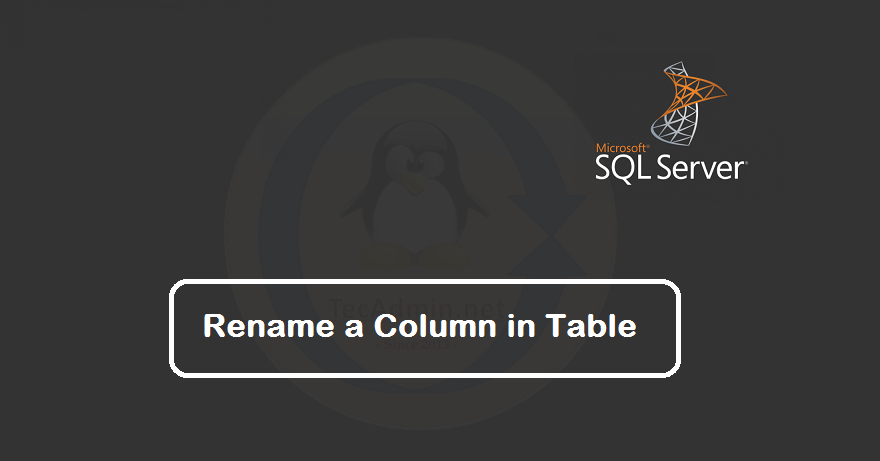Python, a general-purpose language with a clean syntax, is a great tool for automating tasks like counting the number of lines in a file. This is useful when you need to analyze large text files, data logs, or code bases. In this article, we will discuss how to create a Python program that can count the number of lines in a file. Before we start, ensure that you have Python installed on your computer. As of my knowledge inn July 2023, the most recent stable version of Python is 3.11. However, any version after Python 3 should work fine for…
Author: Rahul
Database design is the organization of data. A good database design makes it successful. Its recommended to follow a good pattern for the table names and their columns. In some cases, you may be required to rename a column name of the table to maintain a proper architecture and naming pattern. The sp_rename stored procedure is used to rename a column name in a table in MSSQL server database. Syntax: The syntax of the sp_rename stored procedure is: sp_rename ‘TableName.[OldColumnName]’ , ‘[NewColumnName]’, ‘COLUMN’ Caution: Changing any part of an object name could break scripts and stored procedures. Make sure to…
Did you know that Amazon Linux is a freely-available and supported operating system that is tailor-made for AWS? It’s true! Amazon has launched a new version of its Linux distribution — Amazon Linux version 2 (Amazon Linux v2), which comes with some really interesting features and enhancements. This blog post introduces you to the new version of Amazon Linux, covers its key features, and teaches you how to install Apache & PHP on Amazon Linux 2. Let’s get started! Step 1 – Initial Setup Log in to your Amazon Linux 2 system via SSH. Its good to keep packages up…
When you run a production database, you need a reliable solution that has fast recovery times, won’t crash your applications, and meets the performance demands of your users. That doesn’t mean you have to spend a ton of cash either. Amazon provides services that make it easy to deploy new databases on their infrastructure without needing to know too much about how these things work. This article will walk through the process of installing MySQL 5.7 on Amazon Linux 2. Prerequisites Login to your Fedora system and open a terminal. Now upgrade the current packages to the latest version by…
Angular is an javascript frameworks, libraries, assets, and utilities. This tutorial will help you to create an Angular application using the Angular CLI tool on any platform. The angular project provides and Command Line Interface called Angular CLI for the automation. You can do automating operations in Angular projects instead of doing them manually and save the time and effort. Using the Angular CLI, You can do the followings: Creating new project. Setup application Environment. Manage application configurations. Building components, services and routing system. Starting application, testing and deploying the project. Installing 3rd party libraries like Bootstrap, Sass etc. Let’s…
Angular is an frameworks, libraries, assets, and utilities. It keeps track of all the components and checks regularly for their updates. This tutorial will help you to install the Angular CLI tool on Ubuntu 19.10, 18.04 & 16.04 Linux operating systems. Reference: Serve Node.js Application behind the Apache Server Step 1 – Install Node.js First of all, you need to install node.js on your system. If you don’t have node.js installed use the following set of commands to add node.js PPA in your Ubuntu system and install it. sudo apt install python-software-properties curl -sL https://deb.nodesource.com/setup_14.x | sudo -E bash -…
Memcached is a distributed memory object caching system which stored data in memory on key-value basis. It is very useful for optimizing dynamic websites and enabled speed by caching objects in memory. Read more about memcache. This article will help you to install Memcached on Fedora Linux systems. Install Memcached on Fedora Memcached is available under default Fedora repositories. You can install it by running the following command on your Fedora Linux system. sudo dnf install memcached -y Now start the Memcached service using the following commands. sudo systemctl enable memcached.service sudo systemctl start memcached.service Memcached Configuration Edit the Memcached…
Wine (originally an acronym for “Wine Is Not an Emulator”) is a compatibility layer capable of running Windows applications on several POSIX-compliant operating systems, such as Linux, macOS, & BSD. The Winehq team has announced the latest stable release 7.0 on January 18, 2022. Its source code is available for download from its official site. You may also use the package manager to install wine. Wine is an Open Source implementation of the Windows API and will always be free software. This article will help you to install Wine 7.0 Stable Release on Debian 10 Buster Linux system using the…
MX Linux is a cooperative venture between the antiX and former MEPIS communities. The MX Linux, version 18.3 is the latest version available to download. Ubuntu MX Linux 18.03 Download Links Please find below DVD ISO images download links for Ubuntu Desktop and Ubuntu server edition. You can also use torrent to download images. MX-18.3_x64.iso [torrent] MX-18.3_386.iso [torrent]
JSON (JavaScript Object Notation) is a popular lightweight data interchange format used for exchanging data between servers and clients. While it is designed to be human-readable, JSON files can sometimes become difficult to read and understand, especially when dealing with large or complex data structures. In such cases, pretty printing JSON files becomes essential for better readability and debugging. In this article, we will show you how to pretty print JSON files in Linux using the `json_pp` command, a built-in JSON processor. Understanding the json_pp Command The `json_pp` command is a JSON preprocessor that ships with Perl, which is typically…


